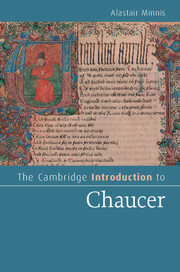Book contents
- Frontmatter
- Contents
- List of illustrations
- List of abbreviations
- Introduction Life and historical contexts
- Chapter 1 Love and lore: the shorter poems
- Chapter 2 Fictions of antiquity: Troilus and Criseyde and The Legend of Good Women
- Chapter 3 The Canterbury Tales, I: war, love, laughter
- Chapter 4 The Canterbury Tales, II: experience and authority
- Afterword
- Notes
- Further reading
- Index
Afterword
Published online by Cambridge University Press: 05 October 2014
- Frontmatter
- Contents
- List of illustrations
- List of abbreviations
- Introduction Life and historical contexts
- Chapter 1 Love and lore: the shorter poems
- Chapter 2 Fictions of antiquity: Troilus and Criseyde and The Legend of Good Women
- Chapter 3 The Canterbury Tales, I: war, love, laughter
- Chapter 4 The Canterbury Tales, II: experience and authority
- Afterword
- Notes
- Further reading
- Index
Summary
A squire removes the hood from his falcon’s head and releases it from his gloved hand. It climbs into the sky and circles, seeking its prey. Then, in an instant, feathers become metal, the silent soaring of the bird gives way to the roar of a powerful piston engine. A medieval killing machine has morphed into a modern one, a Spitfire fighter plane. When we return to the squire, he has doffed his medieval costume and now is dressed as a soldier, complete with steel helmet and fixed bayonet.
Here I have described part of the opening sequence from the 1944 film A Canterbury Tale, directed by Emeric Pressburger and Michael Powell. An idyllic depiction of Chaucer’s pilgrims traveling towards Canterbury prefaces a tale that owes nothing to any of Chaucer’s own narratives, being a whimsical account of how three strangers – a British army sergeant, an American GI and a ‘Land Girl’– are accidentally thrown together in a small Kent town and confront a minor local mystery. A delicate depiction of rural England threatened by wartime change emerges. Chaucer’s characters, and images of the town of Canterbury itself, have been deployed in the moving evocation of a type of Englishness that may never be the same again.
- Type
- Chapter
- Information
- The Cambridge Introduction to Chaucer , pp. 139 - 144Publisher: Cambridge University PressPrint publication year: 2014

